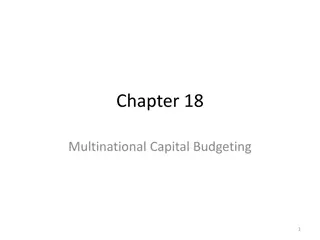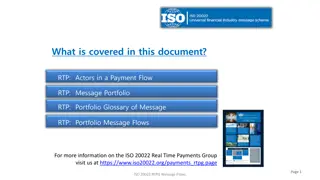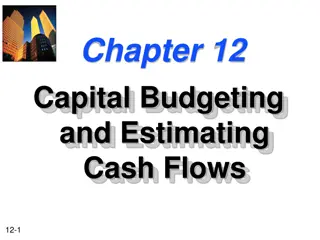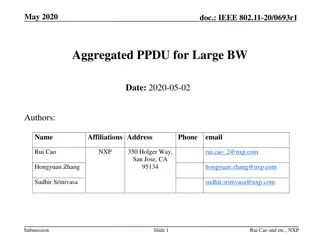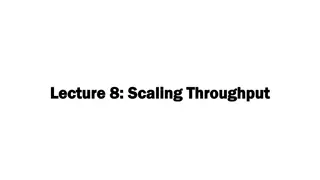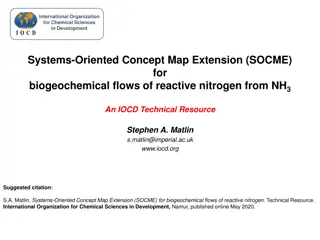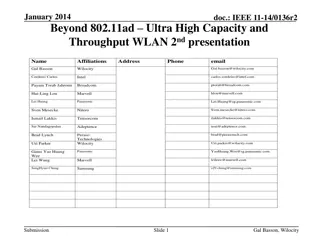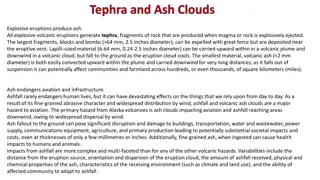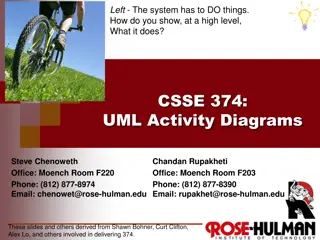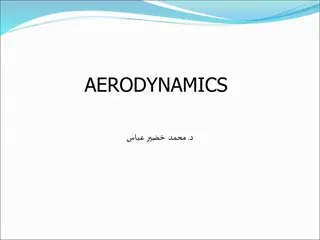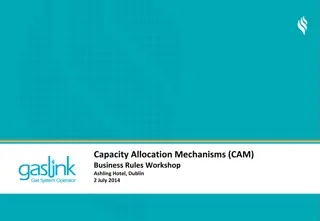Managing Business Process Flows - Throughput and Capacity Analysis
Explore the concepts of throughput and capacity from the book "Managing Business Process Flows" through a detailed lecture discussing utilization, inventory, flow time, and Little's Law. The analysis includes scenarios like computing average inventory, theoretical flow time, handling contracts per day, and determining the number of professionals needed to process cases efficiently. Cross-training is also explored as a strategy to increase system capacity.
Uploaded on Oct 03, 2024 | 0 Views
Download Presentation

Please find below an Image/Link to download the presentation.
The content on the website is provided AS IS for your information and personal use only. It may not be sold, licensed, or shared on other websites without obtaining consent from the author.If you encounter any issues during the download, it is possible that the publisher has removed the file from their server.
You are allowed to download the files provided on this website for personal or commercial use, subject to the condition that they are used lawfully. All files are the property of their respective owners.
The content on the website is provided AS IS for your information and personal use only. It may not be sold, licensed, or shared on other websites without obtaining consent from the author.
E N D
Presentation Transcript
More on Throughput & Capacity https://youtu.be/EkwteDoj6Rg Based on the book: Managing Business Process Flows.
Recorded Lecture Throughput Basic Problems. A. Asef-Vaziri. 2
Utilization, Inventory, Flow Time, Littles Law Operation 3 Senior Partner Operation 1 Paralegals Operation 2 Tax Lawyers Tp=2 hr., c = 2 Rp=1/hr, 8/dy Tp=20/3 hr., c= 4 Rp = 0.6/hr, 4.8/dy Tp=2 hr., c=3 Rp=1.5/hr, 12/dy a) Suppose throughput is 3.6 contracts per day. Compute the average inventory in the processors. a1) Using utilizations Station Station1 Station2 Station3 I = 3+0.9+0.9= 4.8 Rp 4.8 12 8 R 3.6 3.6 3.6 U 0.75 0.3 .45 c 4 3 2 Ip 4* 0.75 = 3 3* 0.3 = 0.9 2*0.45 = 0.9 Throughput Basic Problems. A. Asef-Vaziri. 3
Utilization, Inventory, Flow Time, Littles Law a2) Using the Little s Law Theoretical Flow Time = 6.66667+2+2= 10.66667 RT=I 3.6(10.66667/8) = I I = 4.8 Or (3.6/8)(10.66667) = 4.8 b) Suppose there are 16.8 contracts waiting in different waiting lines? What is the Flow Time ? RT=I 3.6T= 16.8+4.8 = 21.6 3.6T = 21.6 T=6 days Throughput Basic Problems. A. Asef-Vaziri. 4
Implied Utilization Operation 3 Senior Partner Operation 1 Paralegals Operation 2 Tax Lawyers Tp=2 hr., c = 2 Rp=1/hr, 8/d Tp=20/3 hr., c= 4 Rp = 0.6/hr, 4.8/dy Tp=2 hr., c=3 Rp=1.5/hr, 12/dy c) Can the company handle 150 cases per month? R/day = 150/20 R= 7.5 per day, Rp (Capacity) =4.8 Implied Utilization =7.5/4.8 = 1.5625 d) If the firm wishes to process all the 150 cases, how many professionals of each type are needed? # of paralegals required = 7.5/1.2 = 6.25 # of tax lawyers required = 7.5/4 = 1.875 # of senior lawyers required = 7.5/4 = 1.875 Throughput Basic Problems. A. Asef-Vaziri. 5
Resources We need 6.25, 1.875, and 1.875 resources. Or indeed 7, 2, and 2. We have 4, 3, and 2. We may hire 3 additional paralegals. Alternatively, we may hire just 2 and have 6 paralegals. They need to work overtime for 0.25 paralegal who works 8 hrs /day. 0.25(8) = 2 hours total over time. There will be 6 paralegals; over time pf each = 2/6 = 1/3 hour Or 20 minute per paralegal. PLUS some safety Capacity. Or we may use tax lawyers as flexible recourses and they may help the paralegals( Flexible resources can increase capacity). Suppose we have two resources. And they work sequentially. They are both expert in their own task Throughput Basic Problems. A. Asef-Vaziri. 6
Cross-Training (Flexibility) Increases Capacity. Suppose the first resource completes its task in 5 mins (Tp=5 mins). Rp=60/5 =12 per hour. Suppose the second resource completes its task in 10 mins (Tp=10 mins). Rp=60/10 =6 per hour. Both resources are highly specialized in their task. The capacity of the system is 6 per hours. Now suppose the first resource is cross-trained (we increase flexibility of this resource) to do the second job too. But under the new situation, due to moving back and forth, it takes 6 mins to do the first task and 12 mins to do the second task. Under the new situation, he can complete 7 units in the first task (7*6=42) and still has 18 minutes for the second task where s/he can complete 18/12= 1.5 task. By increasing the flexibility, the capacity increases from 6 to 7+. Throughput Basic Problems. A. Asef-Vaziri. 7
Multiple Choice Which of the following 2 statements is true? I. A process can have more than 1 bottleneck resource. II. Having flexible resources can increase capacity. A) Only I B) Only II C) Both I and II D) Neither I nor II E) Cannot be determined Which of the following statement is false? A) Throughput is always smaller than or equal to the capacity. B) Customers may wait even if the utilization of a resource is 80%. C) Bottleneck resources always have 100% utilization. D) Increasing inventory may increase utilization. E) Increasing flexibility of the resources may increase the capacity Throughput Basic Problems. A. Asef-Vaziri. 8
Multiple Choice To improve the utilization, we can I. cross-train the workers II. adopt flexibility equipment III. Combine resources in a resource pool. Choose the most appropriate. A) I B) II C) III D) I, II, and III E) I and II Throughput Basic Problems. A. Asef-Vaziri. 9


